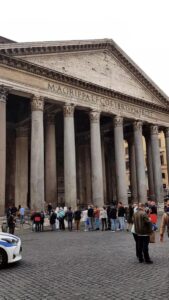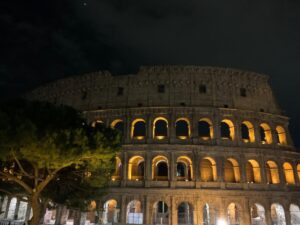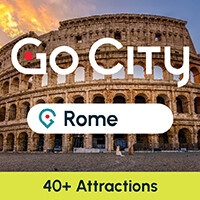Rome is one of those large cities in which the few square kilometers contain an endless quantity of artistic, cultural, naturalistic and culinary attractions known throughout the world. In every corner, in every street, in every square, alley, bridge and garden there is something to visit, discover and learn about. There are hundreds of places to visit in Rome, but often the time at one’s disposal is short and the curious traveler needs to concentrate many stops in the same day, trying to immerse himself or herself as much as possible in the true soul of the city, and then take home the true spirit of Rome. This is why we thought we’d try to select the 12 best places to visit in Rome, grouping them into visit itineraries. Let’s discover them together.
Among the best places to visit in Rome is the Vatican with the Sistine Chapel
Even though you are technically not in Rome or even in Italy, in the heart of Rome is one of the richest places in culture and history in the world: the Vatican City State, the seat of the Pope and the world center of Christianity. It is an incredible place, if we think that in less than half a square kilometer there is an incredible quantity of works of art, architectural jewels, natural wonders and breathtaking views, certainly worthy of being included among the 12 best places to visit in Rome (Italy). By accessing the Vatican Museums you will be able to admire some of the most important masterpieces of sculpture and painting created in the last 2500 years, but also access the very famous Sistine Chapel, the vault of which was painted by Michelangelo Buonarroti, and the Vatican Gardens with their wonderful plants. In the beautiful St. Peter’s Square you are embraced by Bernini’s Colonnade among magnificent fountains and in front of the imposing obelisk, and you can admire the facade of St. Peter’s Basilica which has its entrance from here. After visiting the Basilica and its undergrounds it is also possible to climb the Dome of St. Peter to enjoy the most complete panorama of the city of Rome. A stone’s throw from the Vatican Museums you can also have unforgettable food and wine experiences. In the building that houses the Trionfale Market, Insideat organizes fun cooking classes every day in which you can learn how to prepare pizza cooked in a wood oven, fresh pasta, real Italian gelato and tiramisu. Visit the Insideat catalog to discover all the experiences that are right for you.
Castel Sant’Angelo and Ponte Sant’Angelo
Not far from St. Peter’s Square and the Vatican, follow Via della Conciliazione to reach Castel Sant’Angelo. This monument is among the most visited in Rome and it is famous for being made up of several parts built over almost 1500 years! Its circular shape derives from its having originally been a funerary mausoleum dedicated to the Emperor Hadrian in 139 AD, while the fortifications and buildings placed above it were added between 1440 and 1500 when the Mausoleum became a fortified castle and then a prison. In front of Castel Sant’Angelo is the Ponte Sant’Angelo, the most beautiful bridge in Rome, adorned with original sculptures by Gian Lorenzo Bernini and his students. A magical place to visit in the evening and at night, with the evening lights it becomes a perfect setting for a romantic walk. These exciting places are included in the Angels & Demons walking tour organized by Insideat and inspired by Dan Brown’s books. Book it now!
The Colosseum, the Roman Forum and the Palatine
The Colosseum is the most visited monument in Rome and Italy, one of the most visited in the world. You cannot come to Rome and not pay a visit to the Colosseum. Its original name is the Flavian Amphitheater, a sort of ancient stadium, dedicated to shows and fights. When you visit the Colosseum, however, you can also visit other archaeological attractions around it: the Roman Forum and the Imperial Forums, i.e. the center of Ancient Rome where public life was lived 2000 years ago, the Palatine hill, where the palaces and villas of the Emperors stood, and finally Nero’s Domus Aurea. In addition to the historical and archaeological value of this itinerary, there is also a naturalistic value, given that these places are immersed in nature, among meadows, gardens and vineyards. It’s an excursion not to be missed!
The Circus Maximus and the Aventine
Right behind the Colosseum and the Palatine Hill you enter the Circus Maximus, an enormous open area which still today follows the perimeter of the ancient oval stadium, 600 meters long and 140 meters wide, built between 329 BC and 49 BC. On its sides you can still see the remnants of some original structures, although most of the walls and marble have been removed over the centuries to build other buildings and churches in Rome. Today the Circus Maximus is one of the favorite venues for great Italian and international artists for their concerts. Next to the Circus Maximus is the Municipal Rose Garden of Rome, in which between the end of April and the month of May it is possible to admire the blooms of hundreds of varieties of roses that find their home there and which also participate in the Premio Roma competition. Behind Roseto begins a climb that leads to the Aventine hill, on which there are splendid churches such as the Basilica of Santa Sabina, the Basilica of Santi Bonifacio and Alessio and the Basilica of Sant’Anselmo. Furthermore, right on the Aventine there are two of the best places to visit in Rome in Italy: the Orange Garden, with its stupendous view of the Tiber and the city, and the Grand Priory of Rome of the Order of Malta, a famous place for one peculiar reason: from the keyhole of the entrance portal (which is almost always closed and inaccessible) it is possible to see the Dome of St. Peter in the distance with a unique perspective.
Testaccio, the Pyramid of Cestius and the Non-Catholic Cemetery
Beyond the Aventine Hill you arrive at the Pyramid of Cestius and Porta San Paolo, one of the gates of the ancient Aurelian Walls that surrounded Rome. The Pyramid is the funerary monument of Gaius Cestius and was located right next to the walls of the ancient city, but outside of it, like all the other tombs. Today next to the Pyramid stands the Non-Catholic Cemetery of Rome, in which there is a Jewish cemetery but also the English Cemetery with its fascinating tombs of historical figures, artists, poets etc., such as the English poets John Keats and Percy Bysshe Shelley. The Pyramid is also one of the entry points to the picturesque neighborhood of Testaccio, known for the Monte dei Cocci, an artificial hill formed by fragments of terracotta amphorae that the ancient Romans accumulated here after using them to transport wine and oil on ships. Testaccio is also known for its nightlife, restaurants and exhibition spaces (such as the former slaughterhouse). Today this neighborhood is home to another particular place that attracts the interest of Romans and visitors: the Testaccio Market. It is one of the most famous and well-stocked markets in all of Rome. Here you can buy top-quality food and drinks but also sample traditional Roman and Italian culinary specialities, prepared according to original recipes and with first choice ingredients. If you want to experience a tour of Testaccio and taste what the neighborhood has to offer, we suggest you book Insideat’s Testaccio Street Food Tour!
The Baths of Caracalla and Appia Antica Park with the catacombs
Not far from the Colosseum and the Circus Maximus you enter the park of the Baths of Caracalla, the largest thermal complex in ancient Rome which can be visited today and is magnificently preserved. This park is a destination for thousands of tourists every day, but also for Romans who come here to run to keep fit. In the summer months the Baths of Caracalla become a large open-air theater where concerts and performances take place, including the performances of great operas. Beyond the Baths of Caracalla, the Appia Antica Park begins, one of the largest naturalistic and archaeological parks in the world. Here you can admire the route of the Via Appia Antica, with its churches and archaeological ruins, but also ancient tombs and monuments such as the Mausoleum of Cecilia Metella; but above all you can visit the Christian catacombs of Ancient Rome, those of San Callisto and San Sebastiano.
The Mouth of Truth, the Arch of Janus, the temple of Hercules Victor and the Tiber Island
There are other surprising places near the Circus Maximus. Within a radius of fewer than 300 meters you can visit other wonders known throughout the world: the Bocca della Verità (Mouth of Truth) which is located in the pronaos of the church of Santa Maria in Cosmedin, the Arch of Janus, the Temple of Portunus and the Temple of Hercules Victor, very famous for its circular shape and its columns. These wonders are located a short distance from the banks of the Tiber River, right at the point where a bend forms and which over time has formed an island, the famous Tiber Island. This island is joined to the two banks of the river by two passable bridges. Right from the banks of the river and from the island it is also possible to observe the ruins of the Ponte Rotto (Broken Bridge), an ancient bridge over the Tiber which collapsed several times over the centuries, so much so that it was decided not to rebuild it in that position again.
Trastevere and the Janiculum hill
Next to the Tiber River, near the Tiber Island, stands the most characteristic and lively neighborhood of Rome: Trastevere. Its origins are very ancient, in the era of Ancient Rome the families of workers engaged in the activities that took place along the river lived here, i.e. fishermen, traders, sailors and naval workers. Many of these families were of Jewish origin. Over time it has become a neighborhood characterized by an artistic soul, while historic restaurants, taverns, and artisan shops dedicated to food and wine specialties have sprung up in its alleys. Insideat organizes a Trastevere food tour in the center of Rome right here, one of its immersive experiences most appreciated by travellers. Book it now! Behind Trastevere and the Botanical Garden rises the Janiculum Hill, the panoramic point par excellence of Rome, visited day and night by Romans and tourists to take the most beautiful panoramic photos of Rome and witness the firing of the midday cannon.
Piazza Navona, the Pantheon and Campo de’ Fiori
If you look out from the terrace of the Janiculum, you will immediately notice some particular monuments: the dome of the Pantheon, the bell towers of the church of Sant’Agnese in Agone in Piazza Navona and the woven baroque lantern of the Church of Sant’Ivo alla Sapienza. These wonders are all located a few hundred meters away from each other in some of the most beautiful and famous historic districts of Rome: the Parione, Regola, Sant’Eustachio and Ponte districts. Even just a visit to these small neighborhoods by themselves would satisfy any tourist who comes to visit Rome. It is a concentration of historical, artistic and architectural beauties, as well as the beating heart of the social, cultural and political life of Rome. But not only that, in fact if Piazza Navona is the artistic symbol of Roman Baroque with its churches and fountains, think of Bernini’s Fountain of the Rivers, the square of Campo de’ Fiori is the symbol of Roman gastronomic culture. The most picturesque fruit and vegetable market in Rome takes place every day in this central square and we recommend you visit it. By extending the walk in these districts by a few hundred metres, you then reach Largo di Torre Argentina with its archaeological park and the Jewish quarter (also called the Ghetto). This neighborhood is home to some of the best Roman restaurants where you can try typical Roman and Jewish cuisine, where baccalà (salted cod), artichokes and lamb reign supreme. These neighborhoods are the setting for one of the most complete and tasty food tours in Rome organized by Insideat.
Trevi Fountain, Piazza di Spagna, the Spanish Steps of Trinità dei Monti
Behind the Pantheon, once you have passed Piazza di Pietra, Piazza di Montecitorio and Piazza Colonna, you find Via del Corso, a long street that separates the historic center in two. Having also crossed Via del Corso, we arrive in the most glamorous and elegant area of Rome, that of the Trevi and Colonna districts. Here are the absolute symbols of Italian Baroque art. The first is the Trevi fountain, one of the most visited places in Rome, where thousands of tourists come every day to take photographs and toss coins as good luck for a future return to the city. You absolutely must stop by here to experience this emotion too! Near the Trevi fountain, walking along via del Tritone you arrive at Piazza Barberini where the Tritone fountain and Palazzo Barberini are located and from which you access via Veneto, the street of the Dolce Vita. A little further east of the Trevi fountain, you go up towards the Quirinale hill, where the Quirinale Palace is located, seat of the President of the Italian Republic, with the adjacent Scuderie del Quirinale, a famous exhibition space. A little further north from the Trevi fountain you head towards Piazza di Spagna, a very large square characterized by the presence of the beautiful Barcaccia fountain and the majestic staircase of Trinità dei Monti (Spanish steps). These splendid works have been the setting for many famous films and still are the setting for Roman fashion shows today. Also in the Piazza di Spagna area we recommend a walk along via Condotti, via Frattina and via del Babuino where the shops of the most important fashion brands are located. In Via Margutta, on the other hand, there are splendid artistic workshops. Moving further into the Campo Marzio district we will find the Ara Pacis museum, the Mausoleum of Augustus, the beautiful Via di Ripetta and Piazza del Popolo with its obelisk, its twin churches and the Church of Santa Maria del Popolo which houses masterpieces by Caravaggio. Behind Piazza del Popolo is the Terrazza del Pincio and the park of Villa Borghese begins.
The Campidoglio, the Capitoline Museums and the Vittoriano
Via del Corso opens onto Piazza del Popolo to the north, while to the south it leads to Piazza Venezia, the hub of the historic center of Rome, which has always been the scene of events and celebrations. Right on the south side of the square stands the majestic Altare della Patria, also called Vittoriano. The Mausoleum is dedicated to the King of Italy Vittorio Emanuele II and houses the tomb of the Milite Ignoto, an unknown soldier who died in the First World War. This tomb is watched over night and day by soldiers, sailors and airmen and its eternal flame vibrates in memory of all those fallen in war. Right behind the Altare della Patria there are two famous staircases, placed next to each other: the first is the one that leads to the Basilica of Santa Maria in Ara Coeli, the second is the famous Renaissance staircase of the Cordonata Capitolina that leads to the Campidoglio square. Both the staircase and the Piazza del Campidoglio were designed by Michelangelo Buonarroti. In the square there are the statues of the Dioscuri and the famous statue of Marcus Aurelius on horseback. The Capitoline Museums are located in the two buildings on the sides of the square, called Palazzo Nuovo and Palazzo dei Conservatori, an unmissable destination for art and history enthusiasts. A few steps from the Campidoglio there is also the Theater of Marcellus which connects this area to the Jewish quarter.
The triangle of Basilicas: San Giovanni in Laterano, Santa Maria Maggiore and Santa Croce di Gerusalemme
Moving a few kilometers away from the historic center, but still not very far from the Colosseum and the Monti district, there is a truly beautiful area: the triangle of basilicas. The Basilica of San Giovanni in Laterano, the Basilica of Santa Maria Maggiore and the Basilica of Santa Croce in Gerusalemme form a triangle connected by three very wide and comfortable streets to walk along. You can visit all three in just a few hours. If you want to continue the tour of the basilicas, you can go even further and visit the Basilica of San Lorenzo, located next to the Verano Monumental Cemetery, a very fascinating and quiet place surrounded by greenery. To visit the Basilica of San Paolo Fuori le Mura instead, you need to move further south west, to the Ostiense district. You can reach it by subway or by bus.
CTA: To consult the complete offer of experiences organized by Insideat, you can consult the catalog on the website.
For personalized routes and events, you can receive more information by writing to: info@insideat.eu












